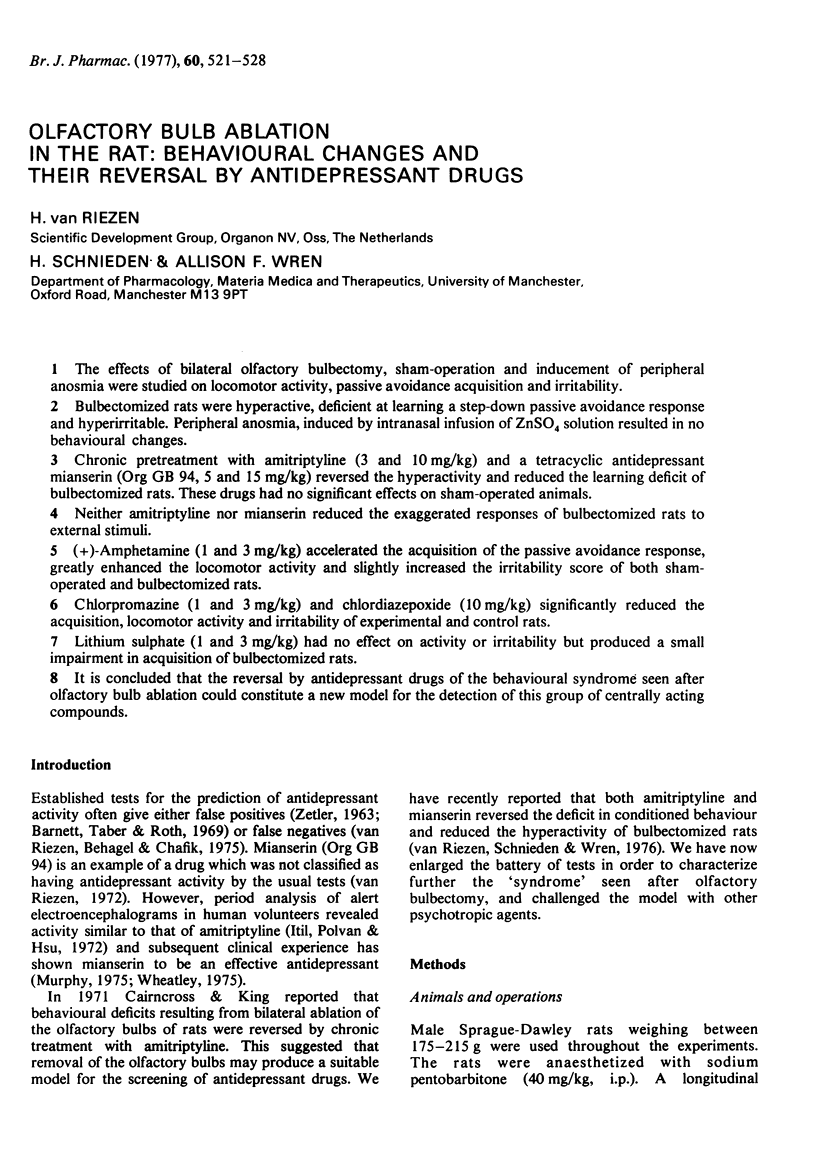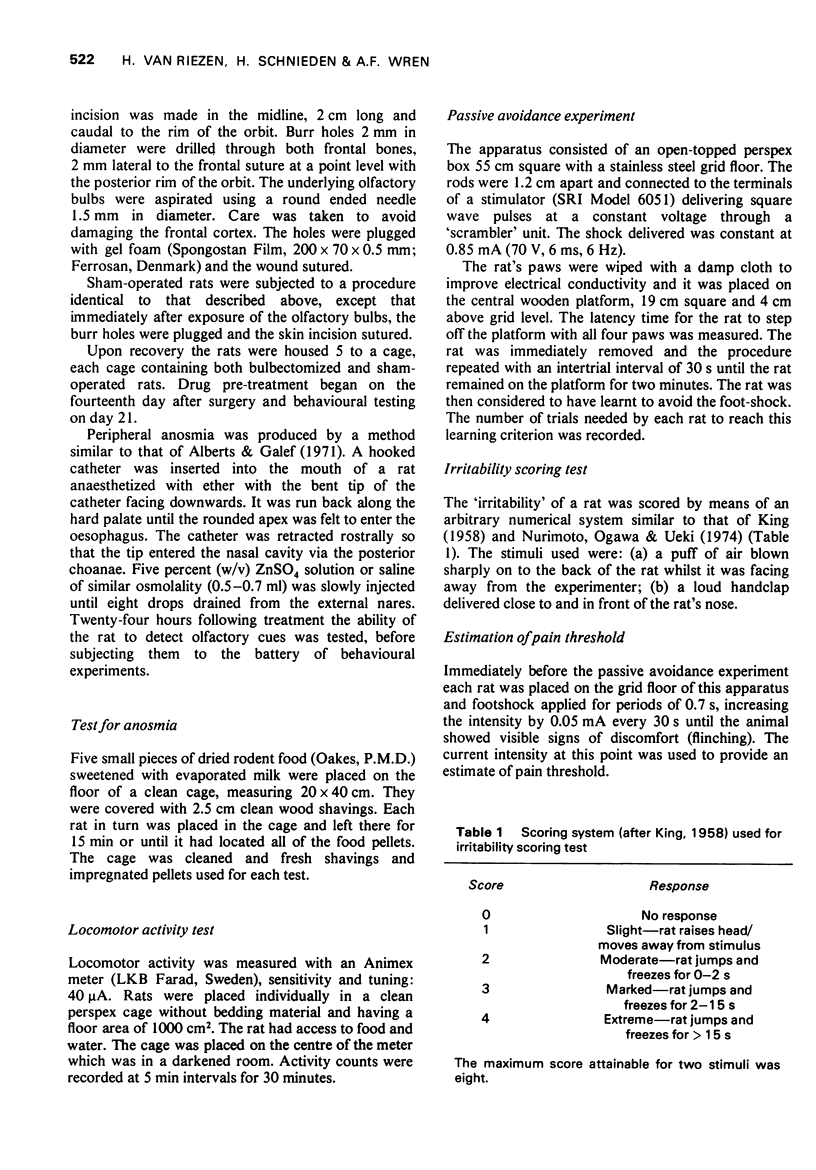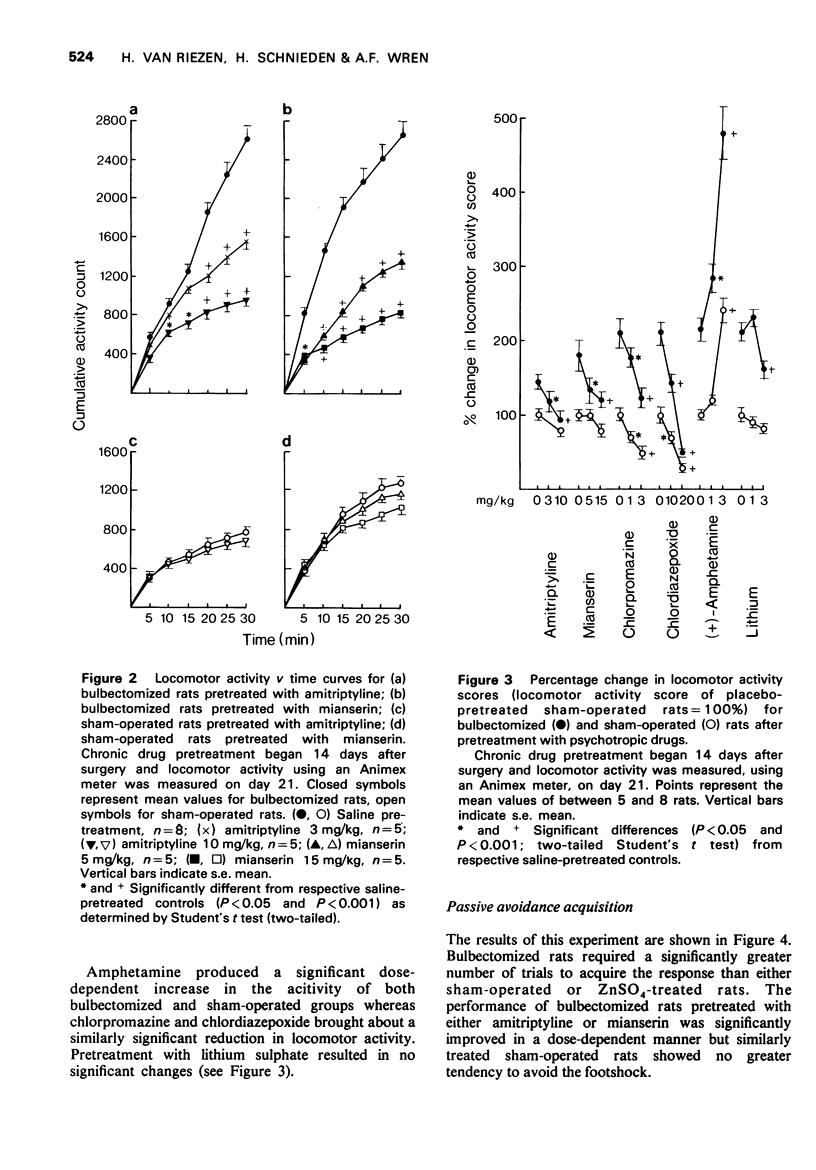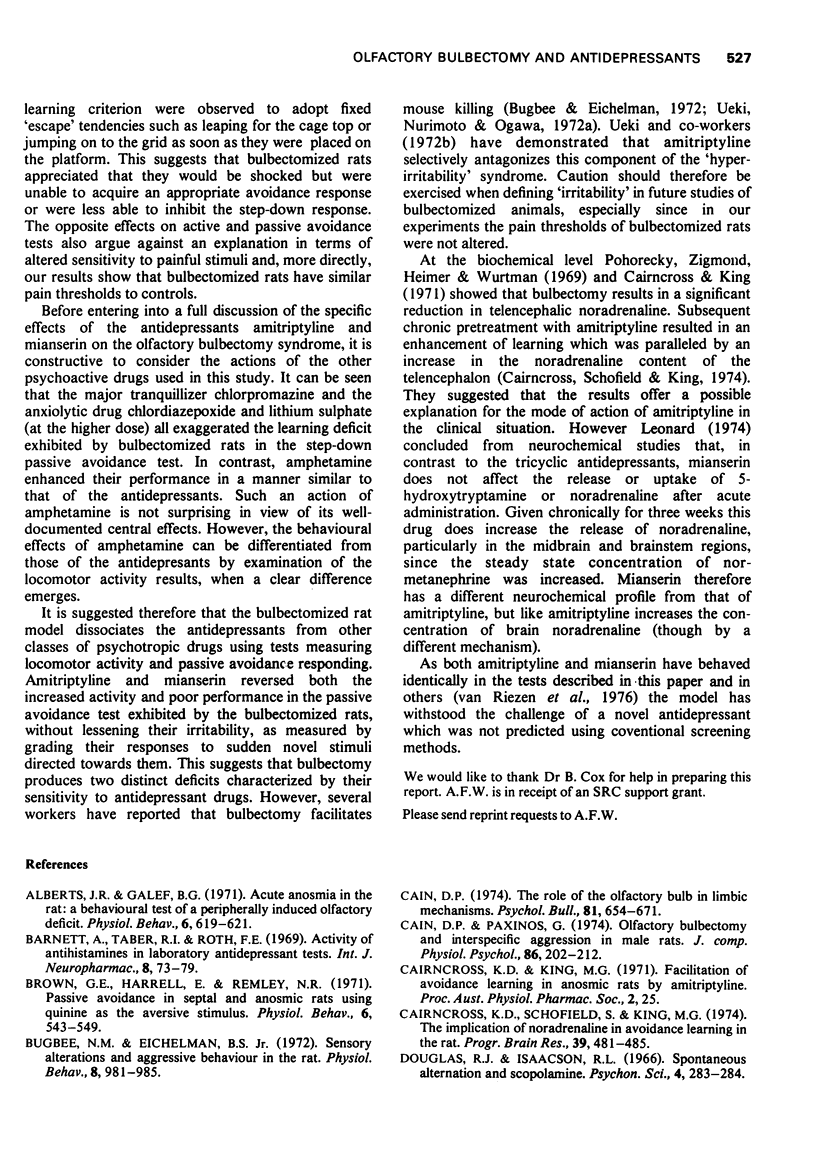Abstract
1. The effects of bilateral olfactory bulbectomy, sham-operation and inducement of peripheral anosmia were studied on locomotor activity, passive avoidance acquisition and irritability. 2. Bulbectomized rats were hyperactive, deficient at learning a step-down passive avoidance response and hyperirritable. Peripheral anosmia, induced by intranasal infusion of ZnSO4 solution resulted in no behavioural changes. 3. Chronic pretreatment with amitriptyline (3 and 10 mg/kg) and a tetracyclic antidepressant mianserin (Org GB 94, 5 and 15 mg/kg) reversed the hyperactivity and reduced the learning deficit of bulbectomized rats. These drugs had no significant effects on sham-operated animals. 4. Neither amitriptyline nor mianserin reduced the exaggerated responses of bulbectomized rats to external stimuli. 5. (+)-Amphetamine (1 and 3 mg/kg) accelerated the acquisition of the passive avoidance response, greatly enhanced the locomotor activity and slightly increased the irritability score of both sham-operated and bulbectomized rats. 6. Chlorpromazine (1 and 3 mg/kg) and chlordiazepoxide (10 mg/kg) significantly reduced the acquisition, locomotor activity and irritability of experimental and control rats. 7. Lithium sulphate (1 and 3 mg/kg) had no effect on activity or irritability but produced a small impairment in acquistion of bulbectomized rats. 8. It is concluded that the reversal by antidepressant drugs of the behavioural syndrome seen after olfactory bulb ablation could constitute a new model for the detection of this group of centrally acting compounds.
Full text
PDF







Selected References
These references are in PubMed. This may not be the complete list of references from this article.
- Alberts J. R., Galef B. G., Jr Acute anosmia in the rat: a behavioral test of a peripherally-induced olfactory deficit. Physiol Behav. 1971 May;6(5):619–621. doi: 10.1016/0031-9384(71)90218-6. [DOI] [PubMed] [Google Scholar]
- Barnett A., Taber R. I., Roth F. E. Activity of antihistamines in laboratory antidepressant tests. Int J Neuropharmacol. 1969 Jan;8(1):73–79. doi: 10.1016/0028-3908(69)90037-9. [DOI] [PubMed] [Google Scholar]
- Brown G. E., Harrell E., Remley N. R. Passive avoidance in septal and anosmic rats using quinine as the aversive stimulus. Physiol Behav. 1971 May;6(5):543–546. doi: 10.1016/0031-9384(71)90202-2. [DOI] [PubMed] [Google Scholar]
- Bugbee N. M., Eichelman B. S., Jr Sensory alterations and aggressive behavior in the rat. Physiol Behav. 1972 Jun;8(6):981–985. doi: 10.1016/0031-9384(72)90184-9. [DOI] [PubMed] [Google Scholar]
- Cain D. P., Paxinos G. Olfactory bulbectomy and mucosal damage: effects on copulation, irritability, and interspecific aggression in male rats. J Comp Physiol Psychol. 1974 Feb;86(2):202–212. doi: 10.1037/h0035932. [DOI] [PubMed] [Google Scholar]
- Cain D. P. The role of the olfactory bulb in limbic mechanisms. Psychol Bull. 1974 Oct;81(10):654–671. doi: 10.1037/h0036954. [DOI] [PubMed] [Google Scholar]
- Cairncross K. D., Schofield S., King H. G. The implication of noradrenaline in avoidance learning in the rat. Prog Brain Res. 1973;39:481–485. doi: 10.1016/S0079-6123(08)64102-3. [DOI] [PubMed] [Google Scholar]
- Hankins W. G., Garcia J., Rusiniak K. W. Dissociation of odor and taste in baitshyness. Behav Biol. 1973 Mar;8(3):407–419. doi: 10.1016/s0091-6773(73)80081-1. [DOI] [PubMed] [Google Scholar]
- Itil T. M., Polvan N., Hsu W. Clinical and EEG effects of GB-94, a "tetracyclic" antidepressant (EEG model in discovery of a new psychotropic drug). Curr Ther Res Clin Exp. 1972 Jul;14(7):395–413. [PubMed] [Google Scholar]
- Leonard B. E. Some effects of a new tetracyclic anti-depressant compound, Org GB 94, on the metabolism of monoamines in the rat brain. Psychopharmacologia. 1974 Apr 23;36(3):221–236. doi: 10.1007/BF00421804. [DOI] [PubMed] [Google Scholar]
- Marks H. E., Remley N. R., Seago J. D., Hastings D. W. Effects of bilateral lesions of the olfactory bulbs of rats on measures of learning and motivation. Physiol Behav. 1971 Jul;7(1):1–6. doi: 10.1016/0031-9384(71)90226-5. [DOI] [PubMed] [Google Scholar]
- Nurimoto S., Ogawa N., Ueki S. Hyperemotionality induced by lesions in the olfactory system of the rat. Jpn J Pharmacol. 1974 Apr;24(2):175–184. doi: 10.1254/jjp.24.175. [DOI] [PubMed] [Google Scholar]
- Pellegrino L. Amygdaloid lesions and behavioral inhibition in the rat. J Comp Physiol Psychol. 1968 Jun;65(3):483–491. doi: 10.1037/h0025807. [DOI] [PubMed] [Google Scholar]
- Pohorecky L. A., Zigmond M. J., Heimer L., Wurtman R. J. Olfactory bulb removal: effects on brain norepinephrine. Proc Natl Acad Sci U S A. 1969 Apr;62(4):1052–1055. doi: 10.1073/pnas.62.4.1052. [DOI] [PMC free article] [PubMed] [Google Scholar]
- Powell T. P., Cowan W. M., Raisman G. The central olfactory connexions. J Anat. 1965 Oct;99(Pt 4):791–813. [PMC free article] [PubMed] [Google Scholar]
- Riezen H., Behagel H., Chafik M. Development of psychotropic drugs. Psychopharmacol Bull. 1975 Apr;11(2):10–15. [PubMed] [Google Scholar]
- Sieck M. H., Gordon B. L. Selective olfactory bulb lesions: reactivity changes and avoidance learning in rats. Physiol Behav. 1972 Oct;9(4):545–552. doi: 10.1016/0031-9384(72)90010-8. [DOI] [PubMed] [Google Scholar]
- Sieck M. H. Selective olfactory system lesions in rats and changes in appetitive and aversive behavior. Physiol Behav. 1973 Apr;10(4):731–739. doi: 10.1016/0031-9384(73)90154-6. [DOI] [PubMed] [Google Scholar]
- Sieck M. H. The role of the olfactory system in avoidance learning and activity. Physiol Behav. 1972 Apr;8(4):705–710. doi: 10.1016/0031-9384(72)90099-6. [DOI] [PubMed] [Google Scholar]
- Thomas J. B. Non-appetitive passive avoidance in rats with septal lesions. Physiol Behav. 1972 Jun;8(6):1087–1092. doi: 10.1016/0031-9384(72)90202-8. [DOI] [PubMed] [Google Scholar]
- Ueki S., Nurimoto S., Ogawa N. Effects of psychotropic drugs on emotional behavior in rats with limbic lesions, with special reference to olfactory bulb ablations. Folia Psychiatr Neurol Jpn. 1972;26(3):245–255. doi: 10.1111/j.1440-1819.1972.tb01130.x. [DOI] [PubMed] [Google Scholar]
- Wheatley D. Controlled clinical trial of a new antidepressant (Org. GB 94) of novel chemical formulation. Curr Ther Res Clin Exp. 1975 Dec;18(6):849–854. [PubMed] [Google Scholar]
- ZETLER G. [The anticataleptic activity of some antidepressives (thymoleptics)]. Arzneimittelforschung. 1963 Feb;13:103–109. [PubMed] [Google Scholar]
- van Riezen H. Different central effects of the 5-HT antagonists mianserine and cyproheptadine. Arch Int Pharmacodyn Ther. 1972 Aug;198(2):256–269. [PubMed] [Google Scholar]
- van Riezen H., Schnieden H., Wren A. Behavioural changes following olfactory bulbectomy in rats: a possible model for the detection of antidepressant drugs [proceedings]. Br J Pharmacol. 1976 Jul;57(3):426P–427P. [PMC free article] [PubMed] [Google Scholar]


